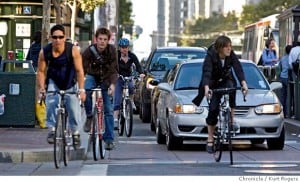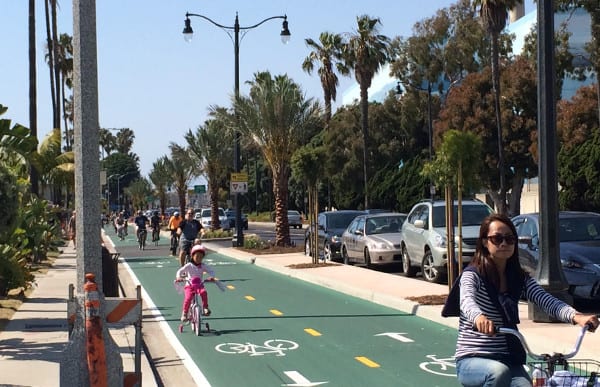Governor Gavin Newsom and the California Legislature officially agreed upon next year’s state budget on June 30, 2022. It is the biggest budget ever set in California, and it includes the most significant amount dedicated to active transportation: $1.05 billion in additional funding.
However, a $1.05 billion increase is only a drop in the bucket of the budget’s $47 billion allocation for infrastructure. The total biking and walking safety allocation represents only 2% of California’s infrastructure budget. It certainly isn’t enough to transform California’s communities into places where the average person will consider biking a safe and convenient transportation option for short trips. In a state ravaged by climate change, we must do better. In reality, even the $2 billion CalBike advocated for was just a down payment on the funding needed to prepare our state for a transition to low-carbon transportation.
Active transportation gets a much-needed boost
The Active Transportation Program (ATP) will receive most of the $1.05 billion increase. The increased ATP budget is significant because the program has historically been short on money compared to the number of projects in the pipeline across the state. The total amount available in Cycle 6 of the ATP is $1.65 billion, a substantial increase over past funding rounds. The additional money will allow the program to greenlight many more projects, so you can expect new and improved biking and walking infrastructure in many communities around California over the next few years.
But CalBike’s work is far from done because the increase doesn’t keep up with the growing demand for active transportation infrastructure improvements. In Cycle 6, local and regional agencies have submitted over $3.1 billion in projects (which have a total cost of over $4 billion), so the infusion is not even close to enough to cover basic active transportation needs, not to mention the transformative changes we need.
Envisioning transformative change for California streets and neighborhoods
California needs transformative change in how we get around, and we need it NOW. Our climate crisis keeps escalating, so we don’t have another 10 years to ponder the next steps. We already know what we need to do because other cities and countries are leading the way, taking steps to make their cities more bikeable, walkable, and sustainable.
California’s 2022 budget is a missed opportunity to allocate the funding California needs to build an equitable and sustainable transportation system that will achieve our state’s climate goals. This year was a critical time to invest in transformative changes since we have an almost $100 billion budget surplus. In an uncertain economy, we may not have another opportunity like this for many years.
EVs won’t save us
The budget for active transportation is small compared to the investment in automobiles in many ways. For example, it includes a $10 billion investment in electric cars over six years, a valuable contribution to climate change mitigation. But EVs still have significant carbon footprints, and mining for the lithium needed to build electric car batteries brings its own environmental havoc. Walkable, bikeable communities are a better solution to the climate crisis.
Policymakers continue to propose investments in electric vehicles as the primary solution to climate collapse, and EVs alone won’t meet California’s climate goals. And the focus on electric cars is even more shortsighted because it fails to meet our societal goals to reduce traffic violence, increase public health, develop more vibrant local communities, and undo the harm that freeways and large roads impose on us all. We don’t just need more infrastructure — we need a transformative mode shift. Continuing to funnel state money into electric vehicles keeps outmoded and harmful mobility patterns in place.
A roadmap for better biking
We must make it convenient and comfortable for many more Californians to take short trips by walking and biking, not driving. To do that, California needs to move quickly to make biking easier — and the signed budget just doesn’t include enough money to build bike infrastructure fast or create the connected networks we need for genuinely bikeable neighborhoods.
CalBike continues to advocate for a separate pot of money for connected bike networks. The fund would give money to communities that commit to building fully connected bike networks quickly — in five years or less. We believe that, by putting some of these projects on the ground soon, we’ll be able to demonstrate the potential of safe, protected bike networks to transform how Californians get around. That will encourage other communities to invest in their own bike networks.
Think about what you need in your community to close the gaps and create safe bike networks and even bicycle highways to get you where you need to go. Neighborhoods with all the services residents need within a 15-minute bike ride would improve safety, air quality, and quality of life. Those are the types of projects that this budget should pay for in every community throughout California. With our historic surplus and in the face of a looming climate crisis, now is the time to transform our state.
We can’t drive ourselves out of the climate crisis. California’s 2022 active transportation budget is an excellent step in the right direction, but we need much more investment in safe streets. CalBike will keep pressing for that funding.




